by Heather Kent | Sep 28, 2017
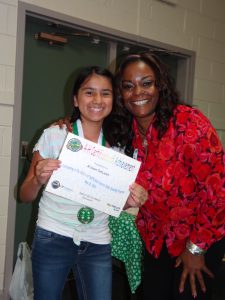 4-H Standards of Excellence are tools to help individual members and clubs set and achieve goals and are part of our recognition model. Recognition is an important part of the 4-H experience; it helps master skills and knowledge by providing feedback on progress towards goals. Standards of Excellence is one of my favorite ways to recognize youth and clubs. Here’s how it works:
4-H Standards of Excellence are tools to help individual members and clubs set and achieve goals and are part of our recognition model. Recognition is an important part of the 4-H experience; it helps master skills and knowledge by providing feedback on progress towards goals. Standards of Excellence is one of my favorite ways to recognize youth and clubs. Here’s how it works:
At the beginning of the 4-H year, youth decide which level of recognition they would like to receive. The levels are bronze, silver, gold and emerald. To help youth decide, they should review the Standard of Excellence matrix with their parent or club leader. The matrix outlines what a member needs to do in order to achieve each level of recognition. For example, if a junior member (ages 8-10) wants to achieve the gold standard, he/she would need to plan to do the following throughout the course of the 4-H year:
- Attend at least 2/3 of club meetings (or number established by club).
- Share project experiences by giving a presentation.
- Attend three different activities
- Participate in three different activities
- Participate in three community service activities
- Participate in four different competitions / exhibitions
- Complete two project record reports
- Teach one club level activity
- Make a poster on “My 4-H Experience” or submit Building My 4-H Portfolio
 But wait, that’s not all! 4-H Clubs can also achieve Standards of Excellence. During the club organizational meeting, members can choose which type of club they want to be (bronze, silver, gold or emerald), and build those requirements into their club plan (most of the items are things that clubs would want to do anyway, so why not be recognized for it?):
But wait, that’s not all! 4-H Clubs can also achieve Standards of Excellence. During the club organizational meeting, members can choose which type of club they want to be (bronze, silver, gold or emerald), and build those requirements into their club plan (most of the items are things that clubs would want to do anyway, so why not be recognized for it?):
- Bronze club- 12/20 items on the list
- Silver club- 14/20 items on the list
- Gold club-16/20 items on the list
- Emerald club- 18/20 items on the list
Once a member or club establishes their goal, they can submit their plan to their club leader. Towards the end of the 4-H Year, the member submits their application to their leader, who signs off on it and submits it to their 4-H agent. Youth are recognized during their County Achievement Night, or Awards Banquet.
Interested in helping? We need volunteers to serve as project mentors, review/judge awards applications or help plan annual recognition programs. Contact your local UF IFAS County Extension Office if you would like to get involved.
by Heather Kent | Jan 13, 2023
Did you know that MLK Day is the only federal holiday designated by US Congress as a national day of service? Instead of a “day off” from school or work, Americans are encouraged to spend the day serving others. Coretta Scott King said:
“The greatest birthday gift my husband could receive is if people of all racial and ethnic backgrounds celebrated the holiday by performing individual acts of kindness through service to others.” MLK Day is always the third Monday of January.
In honor of Dr. Martin Luther King, Jr.’s legacy of service, this blog post brings together several resources to support 4-H service projects to live out our motto, “make the best better.”
What is the Difference Between Service Learning and Community Service?
Service to the community is one of the pillars of 4-H membership. Our pledge includes “My HANDS to larger service.” All 4-H members and clubs are encouraged to plan and execute at least one service project each year. Community service and service learning are often confused. Community service can be court-mandated and sometimes has a negative connotation. However, the biggest difference between community service and service learning is that community service is usually a “one and done” activity where youth collect food, clothes, or other items for a local organization or pick up litter. There is nothing wrong with these types of activities, but youth usually have little input on them, and they are one-time events. This is perfect for younger youth. In contrast, service learning is a longer-term process where youth identify a community need, develop a proposal or plan to address that need, and often involve other community organizations or officials to take action. Service learning is a great way for older youth and teens to develop awareness and empathy. For more information about the differences between service learning and community service, check out our previous blog post.
Getting Youth Involved in Service to Others
Service to others is a huge part of the 4-H Model. Not only is it part of our pledge, Generosity is one of the 4-H Essential Elements, and something we strive to integrate throughout our programming. 4-H Clubs are encourages to participate in at least one community service or service learning project each year- it one of many standards for club and individual members. If you are not familiar with standards of excellence, it is part of our 4-H Awards and Recognition Program. To learn more, check out this previous blog post or be sure to attend our workshop on Awards and Recognition next weekend at our Northwest 4-H Volunteer Forum.
Finally, there is a grant program to help clubs with service learning! It’s called 4-H Community Pride, and not only does this program provide funding for service learning, there is a comprehensive leader’s guide to help volunteers, youth, and parents plan, execute, and celebrate thier service learning.
Ideas to Kick Start Community Service or Service Learning
If you are in need of some fresh ideas for service learning, be sure to read “17 Ways to Kick Start Your Service Learning.” We will also offer a workshop on Service Learning during our Northwest 4-H Volunteer Forum next weekend in Destin, FL. Finally, during our upcoming Northwest 4-H Teen Retreat, youth will have the opportunity to participate in a service project our youth planning committee selected. They will be making teddy bears to give away at a summer camp for youth with disabilities.
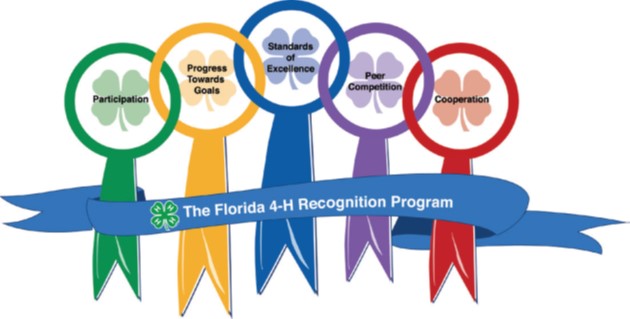
by Niki Crawson | Apr 17, 2020
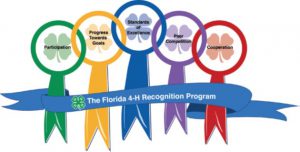 April’s 4-H Virtual Volunteer Leadership Academy on April 16, 2020 was on the importance of awards and recognition. We learned that recognition is important feedback that every individual needs as it helps to give a sense of belonging when a task or achievement occurs. Recognition builds self-esteem and allows for self-reflection and personal growth.
April’s 4-H Virtual Volunteer Leadership Academy on April 16, 2020 was on the importance of awards and recognition. We learned that recognition is important feedback that every individual needs as it helps to give a sense of belonging when a task or achievement occurs. Recognition builds self-esteem and allows for self-reflection and personal growth.
In 4-H, youth members, volunteers, parents, and community partners all want to know that they have been successful in their participation and/or contribution to the program and that they belong in 4-H. All members need to experience recognition for their efforts and that recognition is more meaningful when it occurs soon after it is earned. April’s 4-H Virtual Volunteer Leadership Academy webinar explained that the National 4-H recognition model is based on five areas for recognition: participation, progress toward goals, standards of excellence, competition and cooperation. It also shared helpful tips on creative, low cost ways of recognition that will still send a meaningful message of value and importance to members in the program.
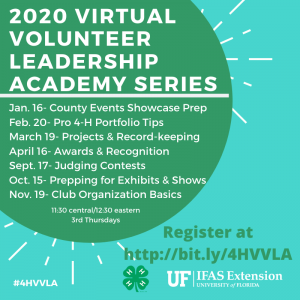 Registration Information
Registration Information
If you were unable to join us for April’s 4-H Virtual Volunteer Leadership Academy, it is not too late to register for future webinar sessions. And, as a registered participant, you will have access to all of the sessions available, including missed sessions, which can be viewed on demand.
Registration is required and can be found at http://bit.ly/4HVVLA Once registered, you can join each session live through Zoom. In addition, if you are unable to connect live, all monthly webinars will be available to you on demand as they are recorded. Register early – seats are limited to the first 100 registrants.
Future 4-H Virtual Volunteer Leadership Academy Webinars
- May – Club Tools for Online Use
- September*- Judging Contests
- October*- Preparing for Exhibits & Shows
- November* – Club Organization Basics
*Fall session registration will be available July 1, 2020.
Webinar Viewing Information
Join each live session simply with one click from your phone, tablet or computer, using the Zoom app. Once you have registered, you will receive email communication regarding the Zoom session links, dates and times.
4-H is one of the largest youth development programs in America with more than 6.5 million young people, ages 5-18, and 540,000 youth and adult volunteers. A variety of fun, educational, engaging activities are offered to teach the fundamental 4-H ideal of practical, “learn by doing” experiences which encourages youth to experiment, innovate and think independently. For information on how you can get involved with 4-H as a youth, volunteer, or supporter, please contact your local UF/IFAS Extension to learn about 4-H in your county.
Resources
by Stefanie Prevatt | Mar 25, 2016
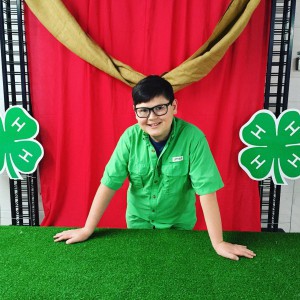
4-H has helped this Washington County youth develop confidence to speak in front of groups. Photo credit: Julie Dillard, UF IFAS
A 2001 Gallup poll found that 40% of Americans suffer from glossophobia, or fear of public speaking. This statistic inspired the famous joke by stand-up comedian Jerry Seinfeld that at most funerals, “the average person would prefer to be the one in the casket rather than the one delivering the eulogy.” Fortunately, 4-H offers an easy antidote through our public speaking program. 4-H public speaking helps youth:
- Demonstrate mastery of a subject
- Practice quality communication
- Increase self-confidence when speaking in front of others.
How and where would you find a 4-H volunteer teaching public speaking? Almost anywhere you’ll find 4-H activities! Here are some examples:
The main public speaking education program supported by your 4-H Office is called County Events.
What is County Events?
County Events is a venue in which 4-H’ers can share what they have learned in their project work though several different contests, including demonstrations and illustrated talks. These are show-and-tell type presentations lasting 3-12 minutes in which a 4-H member shows mastery of a subject matter area. Some contest regulations include:
- Talks must fall between 3-12 minutes for juniors and intermediates, and 5-12 minutes for seniors.
- Team demonstrations must show active, equal participation of both members.
- Presentation must fall under an approved category.
Creating a Presentation
- Topic Selection- should be age appropriate and preferably related to their 4-H project.
- Organizing Thoughts- points should be logical and support the main theme.
- Visuals- neat, attractive and easy to read
- Practice Strategies- club meetings are a great place to practice and practice makes perfect!
Creating Buy in
Last month our Make a Difference Monday online volunteer training addressed ways for club leaders and parents to get their youth excited about public speaking. Regional Specialized 4-H Agent Stacey Ellison shared some creative ideas to encourage youth and families to “buy in” to the idea of public speaking:
- Set expectations
- Have older youth mentor younger youth
- Use the team approach
- Approach it as a game show or cooking show where they can highlight their knowledge or skills
Awards and Recognition
County Events combine two forms of achievement and recognition for youth. These are:
- Peer Competition (a panel of judges subjectively identifies, in a concrete time and place, the best teams or individuals through ranking)
Through this dual recognition system it would be possible for a blue ribbon presentation to place third in peer competition. All 4-H’ers who achieve blue ribbon standard at the county level move forward to the district level of competition.
If you have a passion for public speaking, consider becoming a 4-H volunteer. We are in need of judges for our speech contests as well as speech coaches. For more information on County Events please contact your local UF IFAS County Extension Office or visit http://florida4h.org.
by Heather Kent | Mar 20, 2015
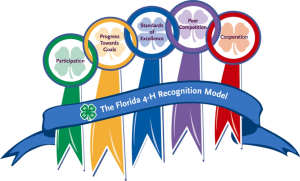
Florida 4-H Recognition Model
Recognition is a basic human need and can help build positive self esteem if handled in the right way and is an important part of the Florida 4-H Program. Whitney Cherry and Karen Miliffe shared tips for club leaders on showing recognition in 4-H clubs during the March Make a Difference Monday session earlier this month. If you missed it, you can view the recorded session at http://florida4h.org/madmondays.
Recognition is more meaningful when it occurs soon after it is earned and is related to a specific task. It can take multiple forms– appropriate recognition varies depending on age, past experience, family lifestyle, community and cultural heritage. Recognition motivates people to excel and take risks and in 4-H, it is the acknowledgement and affirmation of personal growth of an individual or group (such as a club). Awards are simply the things we give people or groups to symbolize our recognition of their accomplishments or effort.
The Florida 4-H Recognition Model includes five types of accomplishments or goals. The five types of accomplishments that 4-H measurers for recognition are:
- Participation in educational experiences (certificates, t-shirts, participation ribbons). The requirements for recognition for participation in a 4-H event are well publicized and easy to achieve. These types of recognition can be earned many times and are usually not expensive, but valued.
- Progress toward self-set goals. It is important for youth to learn to set goals and work towards them. 4-H project books are one way that we provide feedback on self-set goals. The club annual program is a tool for setting the collective goals of the club. As volunteers, we can assist youth with this by reviewing their goals frequently during the 4-H year, identifying what they have accomplished so far and helping them determine their next steps toward a goal.
- Achieving standards of excellence. In 4-H standards are used in two ways:
- Standards are established by subject matter and youth development specialists to provide a basis for young people to plan and work toward their goals
- Professional staff and /or volunteers and young people work together to establish standards– such as dress code at 4-H University, expectations of 4-Hers in club meetings, desired behavior at 4-H events/ camp
- Excelling in peer competition (judging contests, speaking contests, exhibits, animal exhibits and shows, portfolios, project book contests). Competition has long been a component in the 4-H program. 4-H strives to make competition an educational process and an opportunity to teach youth life skills. Peer competition is competing against one another’s peers. Numerous competition exist form the local club level, county, district, state, regional and national. 4-H also provides opportunities for clubs to compete against other clubs with the Club Standards of Excellence and Community Pride programs. Keep in mind that competition is not suitable for all ages (members 5-7 years old) and competition rules and procedures should be clear.
- Excelling in cooperation within a group (team or club awards or media recognition for service projects). From the beginning 4-H has encouraged young people to work together to learn. Cooperation engages young people in group experiences that are interdependent– face-to-face interactions, individual and group responsibility, group skills development. Cooperation involves everyone in the group and uses mutually agreed upon goals.
Recognition is a significant incentive to further learning. When properly used, it inspires young people to belong. Through caring adults and peers, in an inclusive and safe environment, recognition helps meets the needs of young people. Youth become and stay active in 4-H because they benefit. 4-H provides many opportunities for volunteers to make a difference in the lives of young people. If every young person could step into 4-H, imagine all the resourceful problem solvers, skilled workers, and capable leaders they’d become. That future is in our reach if we all lend our time and talents to guide the young people who will create it. Make the investment of a lifetime- become a 4-H volunteer, and inspire the next generation!
 4-H Standards of Excellence are tools to help individual members and clubs set and achieve goals and are part of our recognition model. Recognition is an important part of the 4-H experience; it helps master skills and knowledge by providing feedback on progress towards goals. Standards of Excellence is one of my favorite ways to recognize youth and clubs. Here’s how it works:
4-H Standards of Excellence are tools to help individual members and clubs set and achieve goals and are part of our recognition model. Recognition is an important part of the 4-H experience; it helps master skills and knowledge by providing feedback on progress towards goals. Standards of Excellence is one of my favorite ways to recognize youth and clubs. Here’s how it works: But wait, that’s not all! 4-H Clubs can also achieve Standards of Excellence. During the club organizational meeting, members can choose which type of club they want to be (bronze, silver, gold or emerald), and build those requirements into their club plan (most of the items are things that clubs would want to do anyway, so why not be recognized for it?):
But wait, that’s not all! 4-H Clubs can also achieve Standards of Excellence. During the club organizational meeting, members can choose which type of club they want to be (bronze, silver, gold or emerald), and build those requirements into their club plan (most of the items are things that clubs would want to do anyway, so why not be recognized for it?):




